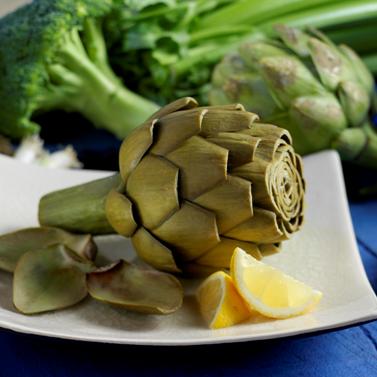Incorporating Mediterranean Produce on U.S. Menus
04 May 2010By Eric Stein, M.S., R.D.
‘ Tis the season for incorporating a wealth of Mediterranean-origin fruits and vegetables in menu development.
Tis the season for incorporating a wealth of Mediterranean-origin fruits and vegetables in menu development.
The spring season brings a major increase in the variety of fresh fruits and vegetables to markets around the country. Some examples of produce that come into harvest in the spring include artichokes, cardoons, citrus, fennel, an assortment of greens and lettuces, spring onions and an array of different herbs. While many of these items are common on restaurant menus in the United States, throughout a variety of cuisines, they also share a common trait that most are also used extensively in the Mediterranean diet.
In recent years there has been a major increase in the assortment of produce coming from the Mediterranean finding its way onto American menus. The Mediterranean diet, which generally includes more fruits and vegetables than in many other areas of the developed world, is widely known for its health benefits such as lower rates of chronic illness. As chefs become more globally oriented in their flavor profiles, their menus are also beginning to reflect the diversity of produce used in other countries.
Artichokes are not new to restaurant menus, but springtime brings a renewed interest in this delicious vegetable. While they are popular in the Mediterranean, nearly 100% of artichokes consumed in this country are grown in California. Artichokes lend themselves well to a variety of preparations including soups, pasta and salads.
While artichokes are both delicious and nutritious, they do require some time to clean and prepare. A cousin to the artichoke is the cardoon, sometimes referred to as artichoke thistle. The buds of this plant can be prepared and eaten like artichokes, but the stalks are much more widely used. The stems, which look like large celery stalks, can be served steamed or braised, and have an artichoke-like flavor.
Prized for their ability to add color, freshness and a burst of flavor, sweet oranges and blood oranges are great for use in salads, sauces and beverages.
Clementines are actually a variety of Mandarin oranges that originated in North Africa. Shamouti oranges are a type of sweet orange of Middle Eastern decent. Both are popular with chefs because of their high juice content and intense orange flavor. Two types of blood oranges that are being used more widely are Tarocco oranges from Italy and Sanguinello oranges from Spain. These are two relatively new species of blood orange that are sweeter than some other types of blood oranges.
Considered indigenous to the Mediterranean, fennel is a highly aromatic vegetable with a strong licorice flavor. Fennel is widely used on spring menus because its bright flavor is synonymous with the freshness of the season. Fennel is amazingly versatile in the ways it can be prepared. Fresh fennel, when shaved into salads or used as a garnish, has a very strong flavor that has hints of mint. Fennel can also be sautéed or roasted to enhance its licorice-like characteristics and caramelize its sugars, making it much more earthy, but also very sweet. Roasted fennel makes an excellent accompaniment to roasted meats, as well as a garnish for soups.
Late winter and early spring brings a bounty of green onions to the farmers’ market. In Spain, a very popular dish, calgots con salsa romesco, features oversized spring onions that are charred over an open flame and then served with a zesty sauce of almonds, bell peppers, tomatoes and olive oil. While it is infrequent that the onions used in this dish in Spain make their way to this country, chefs do replicate this dish using the large green onions of the season.
Arugula, borage, sorrel, nettles and varieties of chard are all types of leafy greens that have made their way from Mediterranean farms to menus here in the United States. Arugula, borage, sorrel and young chard can all be used raw in salads, while nettles and mature chard require being braised. As with all leafy greens, these examples have flavors ranging from spicy to fresh, even cucumber-like.
The best way to incorporate the spring harvest onto the plate is to simply experiment with these different varieties of fruits and vegetables. Try serving braised cardoons as a replacement for roasted carrots as an accompaniment to chicken, or substitute blood oranges for navel oranges in fruit salads. Since these varieties of fruits and vegetables come from cuisines with similar flavor profiles, they also work very well when served together. Freshly shaved fennel is a perfect match for clementines, borage, olives and fresh-herb vinaigrette.
Eric Stein, M.S., R.D., is a chef-instructor in the College of Culinary Arts at Johnson & Wales University, Denver, and serves as the Colorado state coordinator for the American Dietetic Association’s Vegetarian Nutrition Practice Group.
Photo caption: Steamed artichokes. Photo courtesy of Ocean Mist Farms
